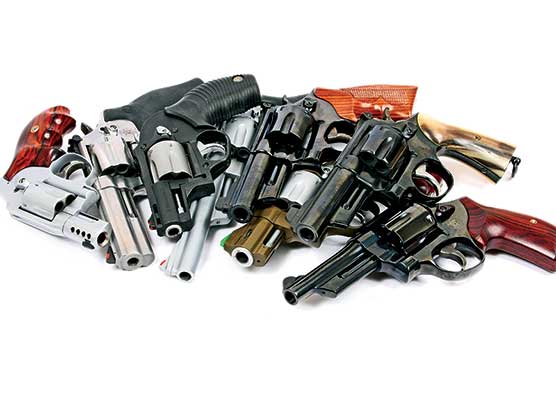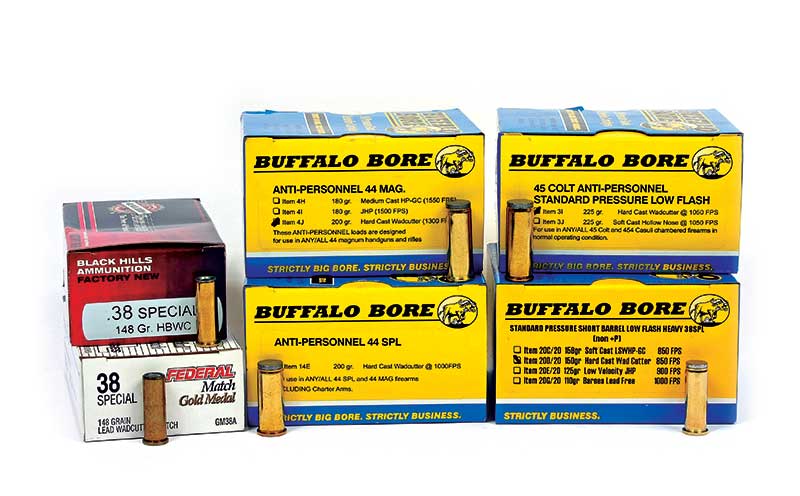Wadcutter Wedgies
Okay, it’s a weird title, I know. But I have to tell you, one of these full wadcutters placed in the right spot on a bad guy or game animal would certainly give them a full wedgie — permanently. I’ve talked about how effective the standard 148-gr. .38 Special target wadcutter can be on animate targets, but things have changed now. With Buffalo Bore’s introduction of full wadcutter loads for the .44 Special, .44 Magnum, .45 Colt, .45 Auto Rim and a heavier .38 Special loading, the bar has been raised quite a bit. After living with these loads for some time now, I thought a quick look at them might be of interest to you.
I gathered a buncha’ guns and standard 148-gr. wadcutter loads from Black Hills and Federal, and a cross-section of the new full wadcutter loads from Tim Sundles of Buffalo Bore, and shot ’em over a chronograph (also did some targeting). Tim confessed to me he was hesitant about whether or not people would understand the value of the big-bore full wadcutter loads — until he released them. Suddenly, experienced handgunners responded with their wallets, snapping up the new loads and returning with stories of how effective they were.
And frankly, I can’t agree more. I used to hunt jackrabbits with standard 148-gr. target wadcutters from a 6″ Model 19. Out to about 50 yards or so, a sitting jack was dead meat, and it made great DA shooting practice. I was shooting thousands of rounds yearly at PPC competition so was pretty tuned-up at the time, but real targets, in the field, were great practice. I’ll always remember the sort of wet “thwack” sound when one of those flat bullets hit a jack. I once hit a running coyote at about 25 or so yards with the same gun/ammo combo, after missing a few shots to catch up to him with the correct lead. The lung/heart shot put him down instantly, more like a rifle shot than that modest wadcutter.
They seem to kill all out of proportion to their loading. A state Humane Officer I knew said it was the only thing he used to put down big animals like cows, horses and the like. I’ve always thought taking the idea to bigger calibers would make sense, but nobody ever did it. A long time ago, the Brits made a “Manstopper” loading for, I think, the .455 Webley, but as I recall they had to stop making it as it was considered “inhumane” to shoot someone with it. Go figure.
Tim’s .38 Special load uses a hard cast, very sharp-shouldered 150-gr. wadcutter at an honest 850 fps from a 2″ barrel revolver (I chrono’d it). This combination of a hard bullet (as opposed to the very soft lead of a target wadcutter) and a bit more velocity makes this load one of the more effective snub-gun loads around, if you ask me. While I’ve shot standard wadcutter load into gel blocks, I’ve not tested this load yet. However, www.brassfetcher.com (who has done a remarkable study on penetration in gel of hundreds of loads) tested the Buffalo Bore 150 wadcutter on 10 percent gel and it penetrated 23.1″. Standard target wadcutters, in my own tests in the past, tend to penetrate around 14″ to about 18″ or so. I’ll take a clean, .36 caliber hole with that kind of penetration any day.
Velocities (averages for each caliber and gun) for the Buffalo Bore .38 Special 150-gr. load were 865 fps from a 2″ revolver barrel, 969 from a 4″, 987 from a 6.5″ and 1,191 from a Marlin .357 lever gun. Stepping out, I’d say.
The .44 Special just adds to the pie. The 200-gr. hard cast full wadcutter did 890 fps from a 3″ revolver, 989 from a 4″, 987 from a 6.5″ and for fun, 1,191 from a Model 92 Winchester rifle (single-loaded).
The .44 Magnum (same bullet) clocked 1,118 from the 3″ gun, 1,210 in the 4″, 1,287 in the 6.5″ and 1,648 in the same Model 92 rifle, single loaded (and thumped my shoulder a tad).
The .45 Colt delivered a 225-gr. hard cast wadcutter at 969 from a 4″ revolver barrel (very manageable) and a quick 1,303 from a Winchester 92 in .45 Colt, also single loaded. This combo in a .45 Colt revolver might qualify as an “ultimate” trail cartridge, especially teamed up with a few CCI shot cartridges.
The Buffalo Bore .45 Auto Rim (+P) managed 1,155 from a 6.5″ 1917 revolver barrel and was a bit snappy. Also serious medicine for that caliber.
Moving along, I tried Federal and Black Hills factory new 148-gr. target wadcutter loads. The trend for both was “around” 625 fps from a 2″ revolver, 700 from a 4″, 690 from a 6.5″ (surprised me there) yet managed in the 820 range from the .357 Marlin rifle. Both rounds were a pleasure to shoot. I have a Mini Martini Cadet rifle re-chambered in .38 Special, and shooting 148 wadcutters in it may be properly classified as one of the more subtly enjoyable things in life.
What’d I learn? You pay for increased velocity in the Buffalo Bore loads with more recoil, muzzle flip, and in the lightweight small guns, they sting a bit. But having said that, I doubt you’ll notice in a real world situation. And frankly, they are not different than any other higher performance load in that respect. Accuracy was spot-on for a wadcutter, and each load delivered target-like accuracy at the 20 yards I was shooting them.
What’s old might be new again, but like they say, “If the shoe fits, wear it.” This concept deserves a hard look for anyone who shoots revolvers for sport or self-defense. Simple is good, and it doesn’t get much simpler than this when it comes to ammo.
Now go have some fun.







